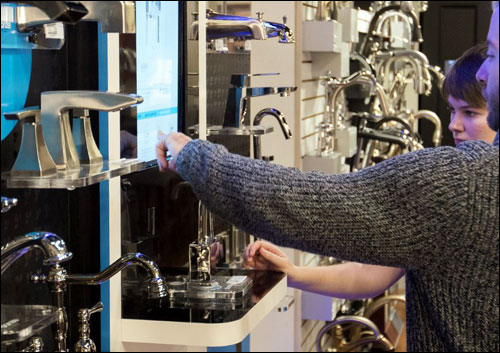Kitchen and bathroom fixture company Danze is employing radio frequency identification to market its products at 250 bath, kitchen and lighting showrooms operated by Ferguson Enterprises. The RFID technology is incorporated into product displays, with the goal of providing a new and more interactive method of demonstrating products to potential customers. The solution enables interior designers and end users to view details regarding a specific fixture, as well as accompanying products, by simply placing a that fixture on a display shelf. The system, developed by retailer and brand solutions company InReality, is designed to be so simple that a user would not have to think about the technology at all, says Gary Lee, InReality’s president and CEO.
Although Danze has no pre-RFID marker against which to compare the displays, the company has indicated to InReality that the RFID-enabled displays offer a greater amount of product information within a smaller space than non-technology enabled displays, and that the touchscreen and the automated data provided via RFID have drawn potential customers to those displays. Danze did not respond to requests for comment for this story.

Ferguson Enterprises operates showrooms throughout the United States, where homeowners, contractors and designers can view plumbing fixtures, lighting and appliances. In 2013, the company’s showrooms began including products from Danze.
Danze approached InReality in early 2013, seeking a technological solution that would make its modular displays more interactive and fun for customers visiting Ferguson. The company wanted something that would set it apart from other kitchen and bathroom fixture providers. Instead of displaying all of its product offerings in a variety of finishes (an option that would require a 30-foot-long display of static product models), the firm sought to offer the same information within a smaller space and in a livelier format.
InReality had experimented with RFID before, says Carl Davis, InReality’s VP for digital solutions, and thus knew that the technology offered the easiest experience for users in comparison with other technologies. QR codes and bar codes, he explains, require that users accomplish a scan before generating any product-specific data, and that step would likely discourage people from participating. Instead, Danze wanted a system that worked without requiring users to employ a scanner or mobile phone to identify specific items.
To achieve this goal, Danze attaches passive high-frequency (HF) 13.56 MHz RFID tags (compliant with the ISO 14443 standard) to pods—small plastic platforms onto which various styles of faucets are mounted. The pods snap onto wall-like modular panels, but interested customers can remove the pods and place them on a smart shelf, which has a touchscreen and a built-in RFID reader and antenna. Each pod’s tag is encoded with a unique ID number, which InReality has linked in its software to data about that product. The software can be updated regularly via an Internet connection, but also operates locally without Internet access. Davis declines to name the tag and reader manufacturers involved, but says that the tags’ makes and models have varied.
When a pod is placed upon a smart shelf, product data is displayed on the screen above that shelf almost immediately. Users can then interact with the touchscreen by selecting a preferred finish, learning more details about that faucet, or viewing other items, such as a complementary kitchen drain. They can also share data about a specific item via social media—on Facebook for example—by simply providing their user name and password. The product is then posted on their page for friends to view.
Danze sent the RFID-enabled pods to each Ferguson location, along with four modular panels and a computer that stores the software. Each pod comes with its tag already encoded with an ID number linked to that particular pod’s product. Lee says InReality specializes in custom solutions that are easy to operate, both for retailers and for their customers. The individuals at Ferguson showrooms, he adds, “are not technical folks—we wanted them to take the pod off the wall, put it on a shelf and it works,” by automatically displaying data on the screen.
“What we’ve created is a way for consumers to engage,” said Michael Werner, Danze’s CEO, in a video that the company posted on YouTube. “We think that a consumer who can engage in a shopping experience by taking a product off the wall and letting an RFID chip bring the computer to life, will be much more likely to select that product. The showroom itself will be much more exciting, and the showroom associates will have tools at their fingertips and be much more knowledgeable—and you’ll be able to sell many more products.”
Danze has been using the system for approximately a year, During that period of time, the company has reported to InReality that it has generated a lot of interest from Ferguson’s customers. “I think we’ll see more and more technology [like this] being used in the retail environment,” Lee states. “The challenge is doing it in a way that doesn’t get in the way” for customers. He cites augmented reality solutions, for example, that can be cumbersome to operate. The more successful installations, Davis reports, are those in which “the technology is invisible.”
Prior to the RFID-enabled displays’ deployment, InReality underwent a testing phase to ensure that the technology did, in fact, work effortlessly for users. That testing included the pods’ design and composition, Lee says, so that tags could be read easily at a short distance.




